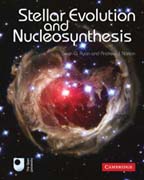
This self-contained astrophysics textbook for advanced undergraduates explores how stars form, what happens to them as they age, and what becomes of them when they die. Students can investigate the physical processes sustaining the energy output of stars during each stage of their evolution and which drive theprogression from one stage to the next, and examine the relationship between different stages of stellar evolution and the production of the chemical elements. The textbook contains a wealth of worked examples and exercises with fullsolutions. Summaries, key facts and equations are clearly identified, and there are full colour illustrations throughout. Drawing on decades of experience in supported learning and independent study, this textbook is an ideal bridging text for astrophysics and physics majors looking to move on from the introductory texts. INDICE: 1. Main sequence stars; 2. Gravitational contraction; 3. Nuclear fusion; 4. From main-sequence to giant branch; 5. Helium-burning stars; 6. Latestages of stellar evolution; 7. Supernovae, neutron stars and black holes; 8.Star formation; Index.
- ISBN: 978-0-521-13320-3
- Editorial: Cambridge University
- Encuadernacion: Rústica
- Páginas: 236
- Fecha Publicación: 07/01/2010
- Nº Volúmenes: 1
- Idioma: Inglés
